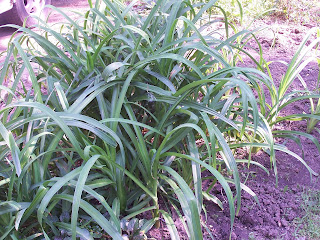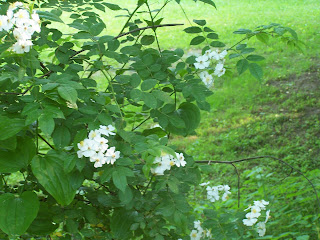(to the tune of "The Twelve Days of Christmas")
On the first day of vacation, we weeded for our son
a rosy purple rhodendron.
On the second day of vacation, we weeded for our son
two bleeding hearts, and a rosy purple rhodendron!
On the third day of vacation, we weeded for our son
three nameless lilies, two bleeding hearts, and a rosy purple rhodedendron.
On the fourth day of vacation, we weeded for our son
four tiny iris, three nameless lilies, two bleeding hearts and a rosy purple rhodedendron.
On the fifth day of vacation, we weeded for our son
five towering pines;
four tiny iris; three nameless lilies; two bleeding hearts;
and a rosy purple rhodedendron.
On the sixth day of vacation, we weeded for our son
six pink Columbine
(and you can read backwards faster than I can write it out!)
On the seventh day of vacation, we weeded for our son
seven spikes of 'sparagras (etc.)
On the eighth day of vacation, we weeded for our son
eight fanning ferns (etc. etc.)
On the ninth day of vacation, we weeded for our son
nine little violets.
On the tenth day of vacation, we weeded for our son
ten greening beans
nine little violets, eight fanning ferns, seven spikes of 'sparagras, six pink Columbine (etc.)
On the eleventh day of vacation, we weeded for our son
eleven red-leafed somethings.
Ten ... nine....eight ....seven .... six ....
On the twelfth day of vacation, we weeded for our son
twelve dozen hastas!
Eleven red-leafed somethings; ten greening beans; nine little violets, eight fanning ferns; seven spikes of 'sparagras; six pink Columbine; five towering pines; four tiny iris; three nameless lilies; two bleeding hearts; and a rosy purple rhodedendron!
So, what that means is that
on the first day of vacation, we pulled out of the ground
a wicked-looking poison ivy vine!
On the second day of vacation, we pulled out of the ground
two piles of dog poop, and a wicked-looking poison ivy vine.
On the third day of vacation, we pulled out of the ground
three kinds of grasses,
two piles of dog poop; and a wicked looking poison ivy vine.
On the fourth day of vacation, we pulled up from the ground
four buckets of clover,
three kinds of grasses, two piles of dog poop, and a wicked looking poison ivy vine!
On the fifth day of vacation, we pulled up from the ground
five acres of dandelions,
four buckets of clover, three kinds of grasses, two piles of dog poop,
and a wicked looking poison ivy vine!
On the sixth day of vacation, we pulled up from the ground
sixty burdock bundles.
Fifty acres of dandelions, four buckets of clover, three kinds of grasses,
and a wicked looking poison ivy vine.
On the seventh day of vacation, we pulled up from the ground
seven leagues of weed vines.
Six ... five... four ... (you know the routine by now!)
On the eighth day of vacation, we pulled up from the ground
eight miles of (Virginia) creeper.
Seven ... six ... (etc. etc.)
On the ninth day of vacation, we pulled up from the ground
eight slimy earthworms,
(etc. backwards again.)
On the tenth day of vacation, we pulled up from the ground
ten thorny thistles,
(you know the routine!)
On the eleventh day of vacation, we pulled up from the ground
eleventeenth tiny critters.....
On the twelfth day of vacation, we pulled up from the ground
twelve multifloras,
eleventeenth small critters, ten thorny thistles, nine slimy earthworms, eight miles of creeper, seven leagues of weed vines, sixty burdock bundles, five acres of dandelions, four buckets of clover, three kinds of grasses, two piles of dog poop, and a wicked looking poison ivy vine!
WOW, are we pooped!
Bruce and MarySue




















































